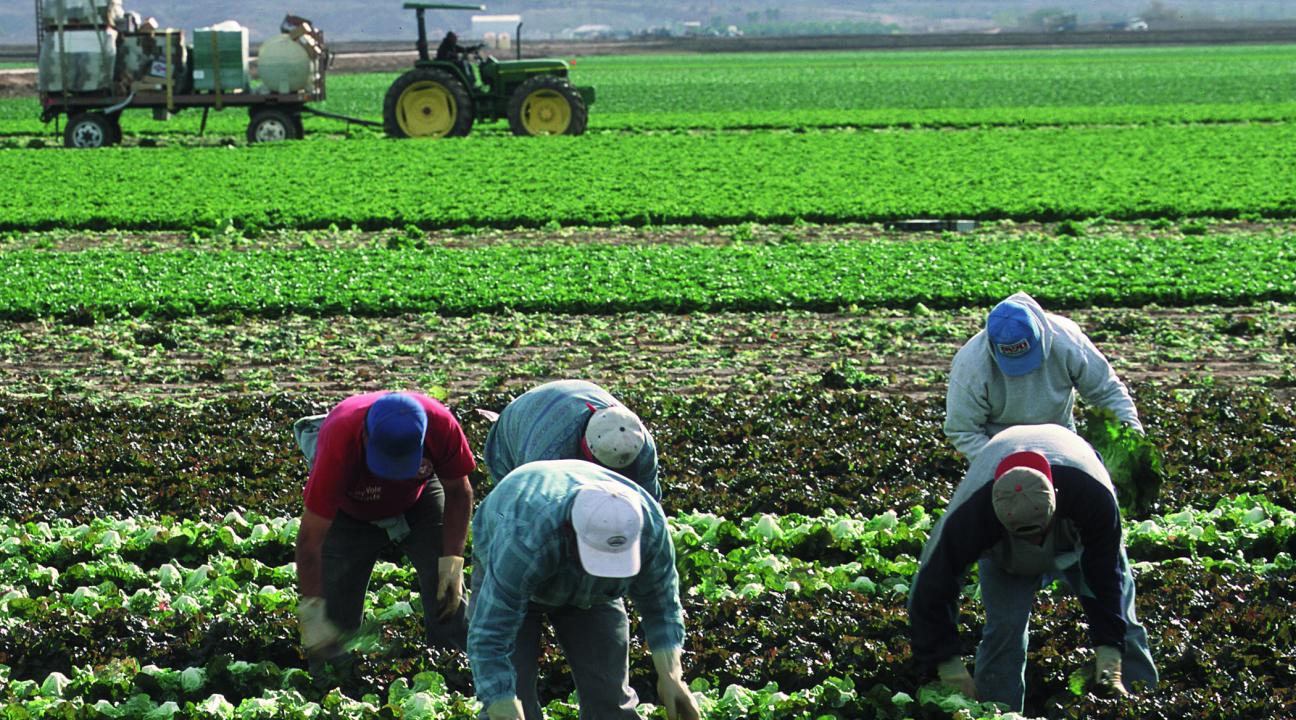The Life of Lettuce
Lettuce is one of the most common food staples in the American diet. Whether it be the base of a salad, or the finishing touch on a sandwich or burger, we eat lettuce A LOT. However, how often do we actually know where that lettuce comes from? There is tremendous amount of work that goes into the production of lettuce, and its impact on our land, resources, and workforce may be much larger than you think. It is not a common practice to think about the steps that a product, especially our food, goes through before ending up on a shelf in the store or on our plate in a restaurant. As the effects of climate change grow more visible with each passing year, it is imperative that we recognize exactly where our resources are going and why. With the agriculture industry being one of the major contributors to global greenhouse gas (GHG) emissions, the better we understand the true costs of our demands for specific food products, the more likely it will lead us to make conscious choices as consumers. Here in the US, it is rare to see lettuce imported or exported, but our consumption and production of it continues to grow. [1] In this blog, we explore the life cycle of the crop and what it really takes to make it available to you year-round. Remember that everything has a cost to you as an individual, society, and the planet.
So where does the journey of a typical head of lettuce begin?
1. The planting and growth of the seed:
Labor - We can't talk about lettuce without talking about the labor needed in order for the industry to function. Lettuce has been nicknamed "green gold" because of its profitability, but with its financial viability also came the need for supervision and regulation. In the 1970s, unions quickly targeted the large, commercial growers and over the next ten years secured contracts that offered competitive entry-level wages and benefits that were rare for seasonal farm workers, such as health insurance and pensions. However, with the rise in illegal migration in the 1980s many union contracts took a hit, and today most lettuce is produced by non-union workers. [2]
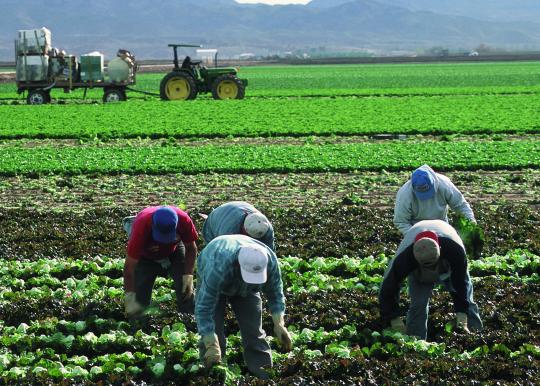
Many lettuce growers have relied on Mexican workers with US immigrant visas who commute daily to their US jobs, hence the nickname "green-card commuters". However, the number of new Mexican-born workers has been decreasing, and the agriculture industry has been one of the first to feel the effects. Between 10% and 20% of farm workers that are employed do not return to the seasonal farm work force the next year. Harvest workers may work up to 50, or even 60, hours a week during the peak times of the year, and it is not easy work. There have been efforts made by the California Labor Commissioner, including the website www.wagetheftisacrime.com, to educate workers on their rights under state labor laws, and in 2012 California's Wage Theft Protection Act (AB 469) went into effect. Still, stricter immigration control has, and will continue, to affect the production of crops in America and without a sustainable workforce, the agriculture industry will need to implement solutions quickly. [3]
Watering - Water, and quite a lot of it, is essential to the healthy growth of lettuce. It is necessary to deeply water lettuce at least once a week during the absence of regular rainfall, and with the increasing severity of droughts, the value of the water needed to produce lettuce will continue to escalate. Some lettuce varieties take 45 to 55 days to mature for harvest, but others, such as Romaine lettuce, can take up to 75 to 85 days before they are ready to be cut. [4]
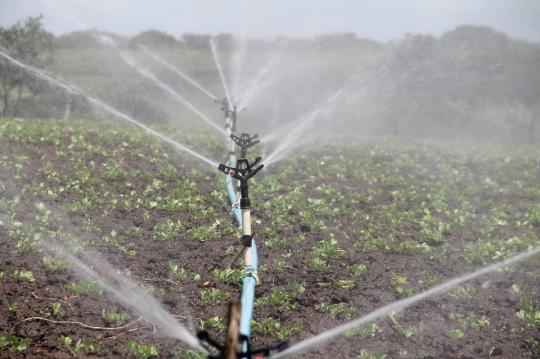
Pesticides - Because of the enormous scale of many commercial lettuce farms, farmers cannot afford to allow pests to threaten the success of their crops so as a precaution many of them spray chemical pesticides to repel the insects. Pesticides can also prevent disease from spreading throughout the crops and lowers the risk of losing a season's harvest. [5] While in theory the use of pesticides seems like a reasonable solution to the issue of pests, there are unintended consequences. Certain pesticides have been linked to cancer, Alzheimer's Disease, ADHD, and birth defects. They also have the potential to harm the nervous system, the reproductive system, and the endocrine system.[6] In 2011, the USDA found 52 potentially harmful pesticide residues on lettuce that was available for Americans to buy and eat. [7] Even if you wash your produce, there may still be pesticides that have seeped into the fruit or vegetable, and while eating a salad grown with pesticides won't kill you, over time the contents build up in your body and can lead to detrimental health effects.

Though pesticides are sprayed on land, they often make their way into nearby water sources, such as a rivers, the ocean, or ponds due to processes like runoff. Contamination of these bodies of water can cause fish and the other animals who rely on the water source to get sick, or even die. Pesticides can also affect groundwater by a process known as leaching. Many people depend on local groundwater for their drinking supply, but once that water is polluted by pesticides it can become unsanitary and harmful to drink. [8]
2. The Harvest of the Lettuce
Although the demand for lettuce continues to grow, most growers are still reluctant to use mechanical one-time harvesters because of the difference in pace that each lettuce head matures. Instead, the common harvesting practice is to have crews of about 40 workers walk behind slow-moving conveyor belts, cut the heads of lettuce and place them on the belt where they are conveyed to packers who wrap them with film and pack them. The only exception is for baby-leaf lettuces which are usually harvested by large, expensive machines that cut up to seven tons an hour; the equivalent work of 140 people harvesting by hand. [9] The first harvest typically accounts for about 75 percent of the yield, but most fields are picked twice.
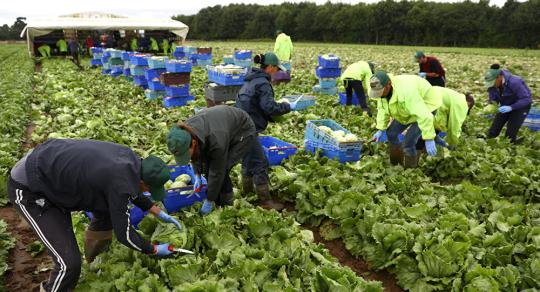
Unless you are someone who only eats lettuce from your local farmer's market, you've most likely eaten lettuce from Yuma, Arizona. The area surrounding Yuma, which includes the Imperial Valley in California, is the source of about 90% of all the leafy vegetables grown in the United States, specifically from November to March when the weather is too cold grow produce in other parts of the country. [10] For six days out the week, about 45,000 farm laborers harvest, trim, and pack lettuce in crews ranging from two to 30 people. In Yuma, also known as the winter lettuce capital of the country, nearly 12 million heads are harvested each day. In just one day, a single crew may harvest more than 40 tons of lettuce, with each cutter responsible for more than 3,000 heads. [11] Not only is cutting lettuce hard work, but it also requires a great deal of skill: "A cutter bends down, grabs a head of lettuce with one hand while making a quick cut at the base of the stem with an 18-inch knife. Next, he lifts the lettuce to his stomach and makes a second cut, trimming the trunk and shaking the outer leaves to the ground. Still holding the blade, he bags the lettuce in a quick motion from a packet that hangs from his belt."[12] For dozens of years, farm workers have done this strenuous labor without much recognition or appreciation from the general public.
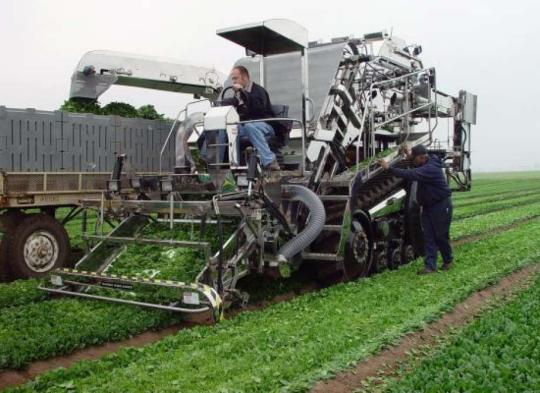
3 .Transportation and Sale of the Lettuce
At the end of each harvest day, giant trucks get ready to transport lettuce all over the United States. At the height of the vegetable season, it is said that close to 1,000 trucks, each carrying about 1,000 boxes of produce destined for grocery stores and restaurants from Seattle to Miami, leave Yuma EVERY night. [13] It is actually incredible to think that every single day of year, almost anywhere in America, you can order a salad at a restaurant or purchase a head of lettuce at the store. This privilege requires a tremendous amount of fossil fuels in order to fuel the trucks that deliver the produce to its targets, as well as a huge commitment of human labor to drive the vehicles, both important resources that often go unacknowledged.
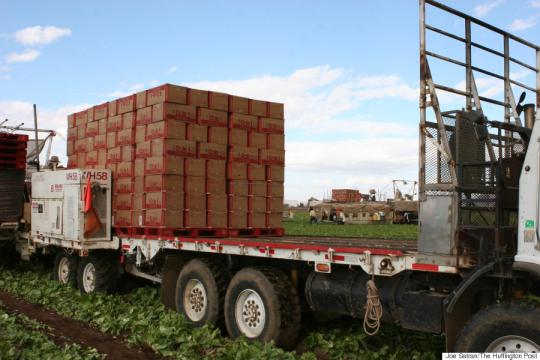
4.So now, what can YOU do?
Now that we have reviewed all the steps that go into growing lettuce, as well as the true costs of its production and availability, you have the opportunity to make a positive impact as a consumer. Here are some tips to keep in mind not only when buying lettuce, but when buying food in general:
- Be conscious of where your lettuce comes from
- Only buy produce when it is in-season
- Shop locally
- Reduce food waste
- Buy organic
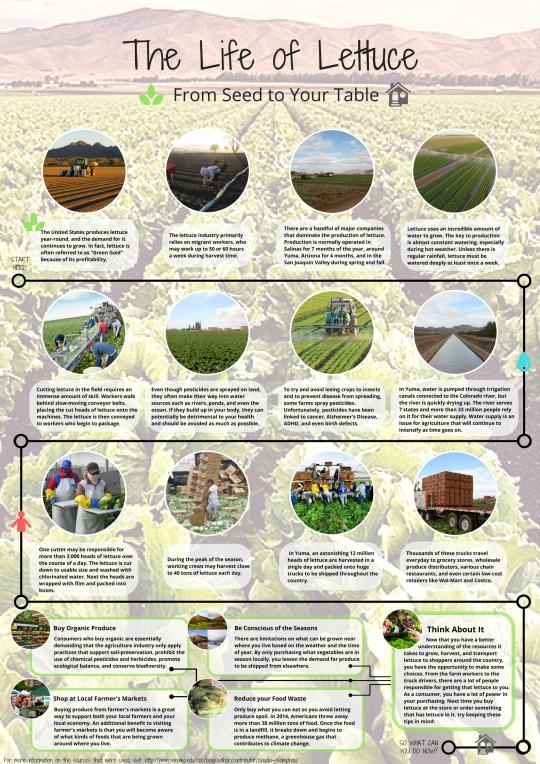
- The United States produces lettuce year-round, and the demand for it continues to grow. In fact, lettuce is often referred to as "Green Gold" because of its profitability.
- The lettuce industry primarily relies on migrant workers, who may work up to 50 or 60 hours a week during harvest time.
- There are a handful of major companies that dominate the production of lettuce. Production is normally operated in Salinas for 7 months of the year, around Yuma, Arizona for 4 months, and in the San Joaquin Valley during spring and fall.
- Lettuce uses an incredible amount of water to grow. The key to production is almost constant watering, especially during hot weather. Unless there is regular rainfall, lettuce must be watered deeply at least once a week.
- In Yuma, water is pumped through irrigation canals connected to the Colorado river, but the river is quickly drying up. The river serves 7 states and more than 33 million people rely on it for their water supply. Water supply is an issue for agriculture that will continue to intensify as time goes on.
- To try and avoid losing crops to insects and to prevent disease from spreading, some farms spray pesticides. Unfortunately, pesticides have been linked to cancer, Alzheimer's Disease, ADHD, and birth defects.
- Even though pesticides are sprayed on land, they often make their way into water sources such as rivers, ponds, and the ocean. If they build up in your body, they can potentially be detrimental to your health and should be avoided as much as possible.
- Cutting lettuce in the field requires an immense amount of skill. Workers walk behind slow-moving conveyor belts, placing the cut heads of lettuce onto the machines. The lettuce is then conveyed to workers who begin to package.
- One cutter may be responsible for more than 3,000 heads of lettuce over the course of a day. The lettuce is cut down to usable size and washed with chlorinated water. Next the heads are wrapped with film and packed into boxes.
- During the peak of the season, working crews may harvest close to 40 tons of lettuce each day.
- In Yuma, an astonishing 12 million heads of lettuce are harvested in a single day and packed onto huge trucks to be shipped throughout the country.
- Thousands of these trucks travel everyday to grocery stores, wholesale produce distributors, various chain restaurants, and low-cost retailers like Wal-Mart and Costco.
Think About It
Now that you have a better understanding of the resources it takes to grow, harvest, and transport lettuce to shoppers around the country, you have the opportunity to make some choices. From the farm workers to the truck drivers, there are a lot of people responsible for getting that lettuce to you. As a consumer, you have a lot of power in your purchasing. Next time you buy lettuce at the store or order something that has lettuce in it, try keeping these tips in mind:
-Buy Organic Produce -
- Consumers who buy organic are essentially demanding that the agriculture industry only apply practices that support soil-preservation, prohibit the use of chemical pesticides and herbicides, promote ecological balance, and conserve biodiversity.
-Shop at Local Farmer's Markets -
- Buying produce from farmer's markets is a great way to support both your local farmers and your local economy. An additional benefit to visiting farmer's markets is that you will become aware of what kinds of foods that are being grown around where you live.
-Be Conscious of the Seasons -
- There are limitations on what can be grown near where you live based on the weather and the time of year. By only purchasing what vegetables are in season locally, you lessen the demand for produce to be shipped from elsewhere.
-Reduce your Food Waste -
- Only buy what you can eat so you avoid letting produce spoil. In 2014, Americans threw away more than 38 million tons of food. Once the food is in a landfill, it breaks down and begins to produce methane, a greenhouse gas that contributes to climate change. [14]
Footnotes
1.https://migration.ucdavis.edu/rmn/more.php?id=1596
2. https://migration.ucdavis.edu/rmn/more.php?id=1596
3. https://migration.ucdavis.edu/rmn/more.php?id=1596
4. https://www.burpee.com/gardenadvicecenter/vegetables/lettuce/all-about-lettuce/article10236.html
5. https://www.nature.com/scitable/blog/green-science/the_dangers_of_pesticides
6. https://www.nature.com/scitable/blog/green-science/the_dangers_of_pesticides
7. https://www.whatsonmyfood.org/food.jsp?food=LT
8. https://www.nature.com/scitable/blog/green-science/the_dangers_of_pesticides
9. https://migration.ucdavis.edu/rmn/more.php?id=1596
10. https://www.huffingtonpost.com/2015/03/04/yuma-lettuce_n_6796398.html
11. https://www.huffingtonpost.com/2015/03/04/yuma-lettuce_n_6796398.html
12. https://archive.azcentral.com/arizonarepublic/viewpoints/articles/20100314thompson14.html
13. https://www.huffingtonpost.com/2015/03/04/yuma-lettuce_n_6796398.html
14. https://www.epa.gov/recycle/reducing-wasted-food-home

Author: Claudia Sisomphou


